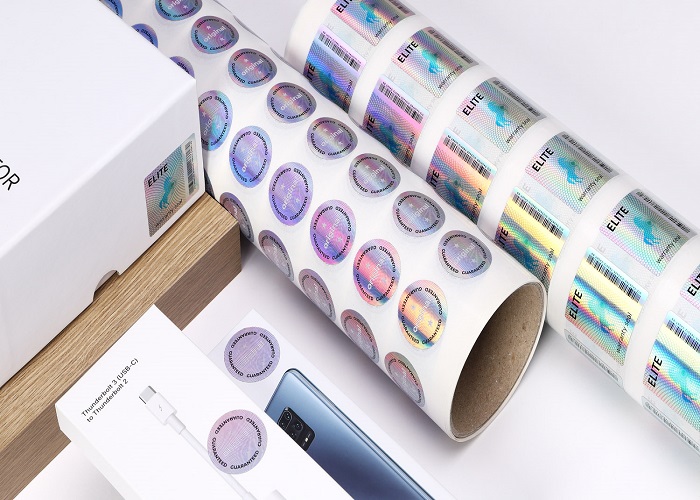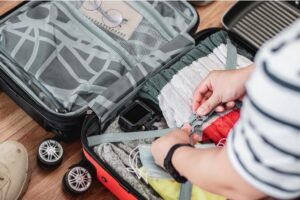
Holograms are like small bits of magic. When you tilt the sticker, a rainbow appears. A symbol, logo, or word seems to float inside the shiny surface. These aren’t ordinary decorations. A sticker hologram protects products, proves authenticity, and prevents tampering.
These stickers help businesses prevent counterfeiting on items like passports and perfume bottles. Their secret power lies in Hologram label, a process that creates detailed images using light instead of ink. Companies like Unicube in Malaysia use this technology to build trust, prevent fraud, and improve security.
So, how do these fascinating stickers work? Let’s explore how light, layers, and clever design come together to form something so useful.
What Is a Hologram?
A hologram is a picture made with light. It shows depth and motion without needing special glasses. Unlike photos, which capture flat images, holograms record how light reflects off a real object from different angles. This gives the illusion of 3D space.
To make a hologram, scientists use lasers. They split a beam in two—one beam lights the object, and the other reflects onto a surface. Where these beams meet, they create a pattern called an interference pattern. This pattern holds all the information about the object’s shape and angle.
When you shine light on a hologram later, the object seems to appear again, even though it’s not there.
How Hologram Stickers Are Made?
Creating a sticker hologram involves multiple steps, all focused on precision. Below is a simplified version of how the process unfolds:
Step 1 – Designing the Master Hologram
- First, experts design the image or logo. They choose how the sticker will reflect light and what angles will show different shapes. They use lasers and photosensitive surfaces to record this image in a lab.
Step 2 – Making the Stamper
- The recorded image is transferred to a metal sheet, which becomes a mould. This metal plate carries the fine details of the design and acts as a master stamp.
Step 3 – Hologram Printing
- Next, the hologram printing stage begins. Technicians use the metal stamper to press the image into a thin plastic film. This film, often made of polyester, gets a layer of shiny metal like aluminium. That’s what gives the sticker its rainbow look.
Step 4 – Adding the Adhesive
- Finally, they add glue on the back and a clear film on the front. This protects the hologram and makes it ready to stick on packaging or documents.
Each sticker becomes hard to copy because the pattern is so complex.
Why Are Hologram Stickers Important?
These small stickers play a big role in modern security. Let’s look at what makes them so valuable.
- Proof of Authenticity: Holograms show that a product is genuine. When you see one, you know it’s from a trusted source.
- Tamper Evidence: If someone peels the sticker, it leaves a mark or breaks apart. This shows the product might have been opened.
- Fraud Prevention: Holograms make it difficult for counterfeiters to create convincing fakes.
- Brand Trust: A shiny, well-made sticker also improves how people see the product.
Companies across industries use these stickers to protect their products, customers, and reputations.
Common Types of Hologram Stickers
Not all holograms are the same. Some are simple. Others hide extra layers of data or change shape when tilted. Let’s explore a few common types.
| Sticker Type | Main Feature |
| 2D/3D Hologram | Layers appear to move and shift |
| Dot Matrix | Bright images made with small light points |
| True Colour Hologram | Photo-like image with real colours |
| Flip-Flop Design | One image changes into another |
| Tamper-Evident Hologram | Breaks or leaves a trace when removed |
| QR Code Hologram | Includes a scan code for tracking |
Every type has its unique role to play. Some dazzle with their brilliance, while others focus on offering superior protection. And then some masterfully combine both traits.
Where Do People Use Hologram Stickers?
1. On Medicine and Supplements
- Doctors, pharmacies, and customers need to know that medicine is safe. A sticker hologram on a bottle or box helps confirm it’s not fake. If the seal breaks, you’ll know something went wrong.
2. On Certificates and Documents
- Schools and colleges place holograms on diplomas to stop forgery. Government offices do the same with IDs and licences.
3. On Electronics and Gadgets
- Phones, computers, chargers—many come with holograms. These stickers show that the parts are original and untampered.
4. On Fashion and Luxury Items
- Bags, shoes, perfumes, and watches often carry custom holograms. This helps buyers spot authentic items and avoid scams.
How Unicube Uses Holograms for Security?
Unicube provides security solutions that include hologram printing and custom label design. They help businesses protect their products with smart stickers, QR-coded labels, and tamper-proof seals.
They also offer tools like the unicube system, which connects digital info to physical items. A customer scans a code and learns where the product came from, when it was packed, and who made it.
Unicube works with industries like education, healthcare, and packaging. Their systems help companies stop loss, track products, and protect trust.
Common Misunderstandings About Hologram Stickers
Some people believe that all shiny stickers are holograms. This is not true. Regular foil stickers reflect light but don’t carry any secure image patterns.
Others think holograms always show 3D objects. While some do, many show flat logos that shift colours or reveal hidden text. The goal isn’t always to look fancy—it’s to stay hard to copy.
Holograms can’t stop every kind of fraud, but they make it much harder for someone to copy or tamper with a product unnoticed.
Holograms vs. Basic Stickers
To understand the difference better, look at this comparison:
| Feature | Hologram Sticker | Basic Foil Sticker |
| Security Level | High | Very low |
| Copy Difficulty | Very hard | Easy |
| Colour Shift | Multi-angle, full spectrum | One-colour shine |
| Tamper Evidence | Yes | No |
| Traceable | Yes (with serials/QRs) | No |
How Holograms Improve Product Safety?
When someone receives a sealed product, they rely on that seal. A good hologram shows that no one has touched the item after packaging. Building trust helps to minimise the risk of fake products or tampering.
Many businesses use serial numbers or scan codes in their holograms, adding another layer of security. A single sticker may reveal ten hidden features, such as microtext, laser dots, or flip images.
By making it harder to remove or copy a sticker, the business keeps control over its brand.
Final Thoughts
Hologram stickers might look small, but they serve a mighty purpose. Built with science, precision, and light, these labels help protect products, people, and reputations.
Through careful hologram printing, each tamper proof sticker hologram becomes a security guard. It stands between the real and the fake, guarding against danger, loss, and doubt.
Companies like Unicube take this work seriously. By offering smart, layered solutions, they give businesses new tools to secure what matters most. Whether it’s a medicine box, a school certificate, or a phone box, one sticker could make all the difference.




